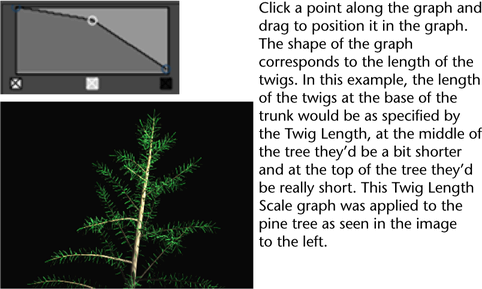These options appear as a subset of the section in the Paint Effects Brush Settings window, and the Attribute Editor for any brush node.
- Twigs In Cluster
-
When twigs are created, they are created in radial clusters at one position around a branch or tube. This setting defines how many twigs are in each cluster.

- Num Twig Clusters
-
Defines the number of radial twig clusters created between the Twig Start and the end of each branch or tube.
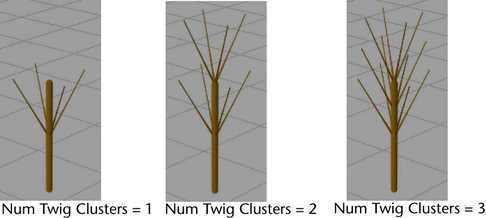
- Twig Dropout
-
Defines the proportion of twigs that are randomly “pruned” to give a more natural look. If Twig Dropout is 0, Paint Effects produces exactly the same number of twigs each time it creates them. If Twig Dropout is 1, all twigs are pruned.
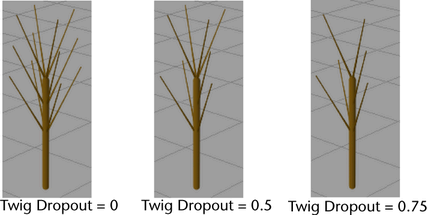
- Twig Length
-
Defines the length of each twig.
- Twig Base Width, Twig Tip Width
-
These settings define the width of the twigs at the base and tip, respectively. The twig width changes linearly between these two values.
Twig width is a factor of the width of the branch that the twig grew from. For example, if you set Twig Base Width to 0.8, then the width of the base of the twig will be 0.8 times the width of the branch at the point where the twig emerged.
- Twig Start
-
Defines the point along a tube where twigs first appear. For example, if Twig Start is set to 0.5, then twigs appear half way up the tube (measured in segments). Decreasing this value pushes the twigs towards the base of the tubes.
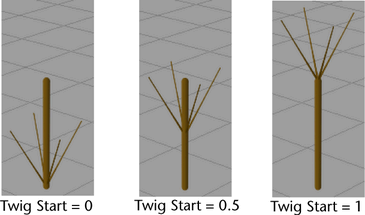
- Twig Angle 1, Twig Angle 2
-
These settings define the range of angles that the twigs will make with their source branch. The first twig cluster created (closest to the root) uses Twig Angle 1, and the last twig cluster created (closest to the tip) uses Twig Angle 2. The angles of the twig clusters change linearly in between these two clusters.
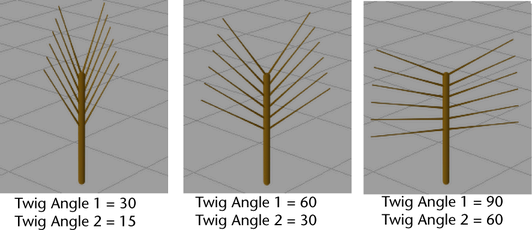
- Twig Twist
-
Defines how much twigs twist around their source branch. If the value is 0, all the twig clusters emerge in a straight line along the branch. Positive or negative values make successive clusters emerge from points twisting around the source branch.
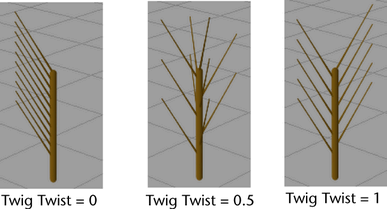
- Twig Stiffness
-
This controls how much twigs are affected by forces such as turbulence, gravity, random and spiral. At a value of one these brush forces will not have an effect. The default is 0.5.
- Branch After Twigs
-
Turn this on to put branches on twigs rather than twigs on branches. If Branch After Twigs is turned on, then twigs are evenly distributed along the main trunk and branches split after the twig. The splitting defined by the branch attributes will occur on the twigs. This is useful in helping define many common tree shapes, such as pines. You can have a central trunk with multiple branches splitting off of it. You can also use Twig Length Scale to adjust the overall profile of the tree. From the twigs' starting point, it controls the density of the twigs and branches along the main trunk. Shorter twigs are adjusted to have fewer branching events and segments.
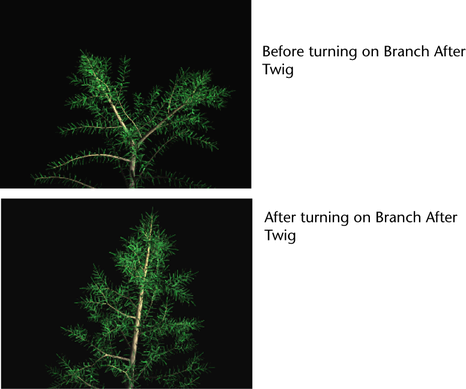
- Twig Length Scale
-
The base length of twigs is defined by the Twig Length attribute. However you might want twigs at the tip of a trunk to be shorter than ones at the base. The Twig Length Scale attribute allows you to scale the Twig Length: when it is set to 1.0 then the twigs will equal the Twig Length value, when it is set to 0.5 the twigs will be half the Twig Length value, etc. The horizontal dimension of the graph corresponds to the position from root to tip of the tube from which the twigs sprout.
